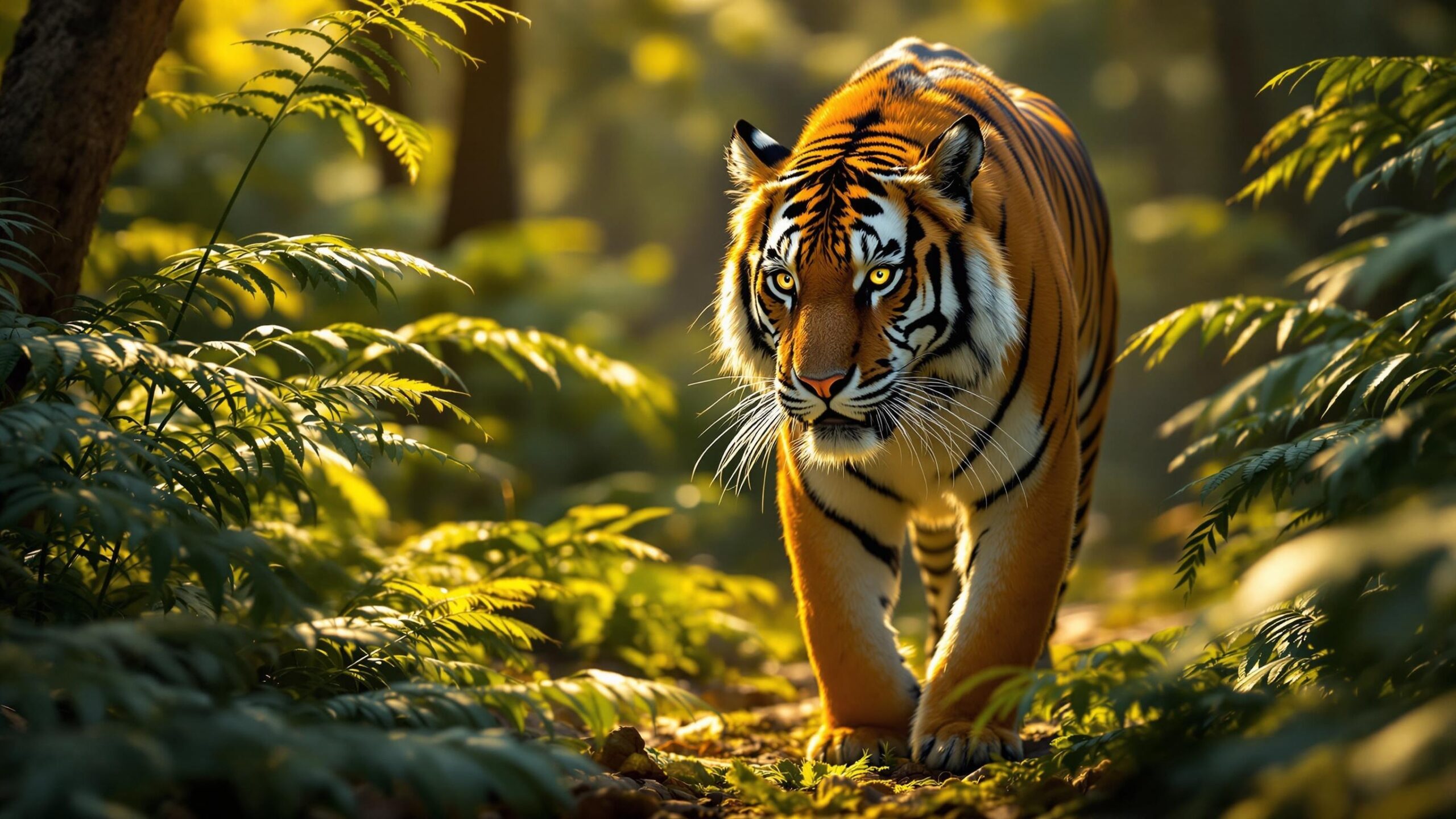Tigers: Striped Shadows of the Wild and Emperors of the Forest
Few animals command awe quite like the tiger. With its flame-colored coat, black stripes, and intense gaze, the tiger embodies both elegance and power. It stalks silently through dense jungles, snowy forests, and swampy mangroves, the very image of a perfect predator—rare, elusive, and utterly mesmerizing. For centuries, tigers have been symbols of strength, fearlessness, and mystique. They are not just the largest of all cats; they are also among the most endangered, making their conservation a global priority and their story one of both wonder and urgency.
Tigers belong to the genus Panthera and are scientifically classified as Panthera tigris. As apex predators, they sit at the top of their ecosystems, controlling prey populations and maintaining the delicate balance of the food chain. Unlike lions, tigers are solitary creatures, operating with stealth and strategy rather than teamwork. They’re masters of camouflage, relying on their environment to conceal themselves until the perfect moment to strike. Their territories can stretch across hundreds of square miles, and within those bounds, they shape the rhythms of the natural world.
This page explores the vast world of tigers—starting with their biological traits and ecological roles, followed by an in-depth look at each of the major tiger subspecies. These sub-categories are distinct not just in geography, but in appearance, behavior, and conservation status. From the snowy ranges of Siberia to the swamps of the Sundarbans, the tiger’s story is one of fierce survival, evolutionary adaptation, and enduring legacy.

Bengal Tiger
Bengal Tiger: The Striped Monarch of the Indian Wild The Bengal tiger, scientifically known as Panthera tigris tigris, reigns supreme as one of the most iconic and majestic animals on Earth. Native to the Indian subcontinent, this powerful feline has captivated imaginations for centuries with its raw beauty, fierce strength, and enigmatic presence in the dense forests, grasslands, and mangroves it calls home. With its brilliant orange coat adorned by

Indochinese Tiger
The Indochinese Tiger: Elusive Guardian of Southeast Asia The Indochinese tiger (Panthera tigris corbetti) is a subspecies of tiger native to Southeast Asia. With its stealthy movements, vibrant orange coat patterned with black stripes, and piercing amber eyes, this elusive big cat captures the imagination of wildlife enthusiasts, conservationists, and researchers alike. Although it is lesser-known than its Bengal or Siberian cousins, the Indochinese tiger plays a critical ecological role

Malayan Tiger
The Malayan Tiger: A Striped Treasure of the Tropical Forests Deep within the dense jungles and verdant rainforests of the Malay Peninsula prowls one of the planet’s most elusive and endangered predators—the Malayan tiger. Known scientifically as Panthera tigris jacksoni, this subspecies of tiger is one of the smallest and most threatened in the world. Agile, powerful, and stunningly beautiful, the Malayan tiger embodies both the majesty of the wild

Siberian Tiger
Siberian Tiger: The Silent King of the Frozen North The Siberian tiger, scientifically named Panthera tigris altaica, is the largest of all tiger subspecies and one of the most awe-inspiring predators to walk the Earth. Roaming the snowy forests and rugged mountains of eastern Russia, particularly the Russian Far East, this big cat embodies survival against the odds. It is a master of stealth, power, and endurance in a world

South China Tiger
The South China Tiger: Rediscovering the Lost King of the Bamboo Forests Once described as the most evolutionary distinct of all tiger subspecies, the South China tiger (Panthera tigris amoyensis) roamed the temperate forests and rolling hills of southern China, a creature of both myth and majesty. Known for its compact form, bold coloring, and legendary ferocity, this tiger was once a symbol of imperial power and wild abundance in

Sumatran Tiger
Sumatran Tiger: The Striped Shadow of the Rainforest Deep in the emerald rainforests of Sumatra, where mist drapes the treetops and the air thrums with life, prowls a creature both beautiful and elusive—the Sumatran tiger (Panthera tigris sumatrae). This remarkable feline, the smallest surviving subspecies of tiger, is a living embodiment of mystery, power, and vulnerability. Found only on the Indonesian island of Sumatra, it is a symbol of both

White Tiger
White Tiger: The Ghost of the Jungle In the lush landscapes of India, where ancient temples rise from forest canopies and rivers wind through tiger country, a creature of legend still prowls. The white tiger (Panthera tigris tigris) is not a separate species or subspecies but a rare and captivating genetic variant of the Bengal tiger. With its snowy coat, piercing blue eyes, and powerful build, the white tiger is
The Biology of a Perfect Predator
Tigers are built for strength and stealth. Adult males typically weigh between 400 and 675 pounds, while females average 250 to 400 pounds. They have muscular limbs, padded paws, and retractable claws that allow them to move quietly through dense underbrush. Their night vision is six times better than that of humans, and their hearing is finely tuned to detect the faintest rustle or cry in the forest.
The tiger’s most iconic feature is its striped coat. No two tigers have the same stripe pattern—each one is as unique as a fingerprint. The stripes help break up their silhouette in tall grass or dappled light, allowing them to disappear into their surroundings. Beneath their stunning fur is thick skin and a solid skeletal frame designed for short bursts of explosive speed and power. Tigers are capable of leaping over 30 feet in a single bound and can take down prey several times their own size.
Their diet includes deer, wild boar, buffalo, and even young elephants or rhinos in rare cases. Tigers are ambush hunters, relying on patience and position. They get as close as possible to their target, then pounce with devastating force, aiming for the neck or throat. After a successful hunt, they drag the kill into cover and often eat over the course of several days, guarding their prize from scavengers.
Tigers are territorial animals, marking their range with scent, claw marks, and vocalizations. A male’s territory typically overlaps with several females, but not with other males. Females raise cubs on their own, nurturing them for up to two years before the young set off to establish their own territories.
The Bengal Tiger: The Icon of the Subcontinent
The Bengal tiger is perhaps the most well-known of all tiger subspecies. Native to India, Bangladesh, Bhutan, and Nepal, this tiger inhabits a range of environments, from dense tropical forests and mangroves to grasslands and marshes. They are the poster animal for tiger conservation and cultural pride in South Asia, featuring in national emblems and folklore alike.
Bengal tigers are large and robust, with vivid orange coats and dark, thick stripes. They are excellent swimmers and frequently bathe in rivers to cool off in the heat. In India’s Sundarbans region, a unique population of Bengal tigers has adapted to life in a tidal swamp, becoming adept at swimming long distances and hunting in muddy, shifting terrain. Bengal tigers are top predators in their habitats, preying on animals like chital deer, nilgai, gaur, and wild boar. They also face significant threats from habitat encroachment, poaching, and conflict with humans. Yet, thanks to focused conservation efforts under India’s Project Tiger initiative, Bengal tigers have seen gradual population recoveries in protected reserves. The Bengal tiger remains a powerful symbol of wilderness and resilience—a creature that commands reverence while standing at the crossroads of extinction and renewal.
The Siberian Tiger: Phantom of the Snow Forest
The Siberian tiger, also known as the Amur tiger, is the largest of all tiger subspecies. Native to the Russian Far East and parts of northeastern China, this magnificent cat has adapted to life in one of the planet’s harshest environments. With temperatures often plunging below -30°F, the Siberian tiger endures by growing a thicker coat and storing more fat beneath its skin.
Siberian tigers are pale in color, with fewer and more widely spaced stripes than their southern relatives. Their massive size helps them retain heat and dominate large prey like elk, red deer, and wild boar. These tigers can travel over 600 miles in search of food or mates, making vast tracts of forest essential to their survival. Siberian tigers are elusive and solitary, rarely seen in the wild. Their population dwindled to fewer than 50 individuals by the 1940s but has since recovered to around 500 due to strong protection measures and scientific monitoring. Conservationists use camera traps, radio collars, and DNA analysis to track their movements and assess genetic health. The Siberian tiger represents not just the physical extremes a predator can survive, but the extraordinary power of global conservation efforts when backed by science, legislation, and international cooperation.
The Sumatran Tiger: The Island’s Endangered Jewel
The Sumatran tiger is the smallest of all tiger subspecies and also one of the most endangered. Found only on the Indonesian island of Sumatra, it has adapted to dense tropical forests, mountain terrain, and peat swamps. These tigers are leaner and more agile than their mainland cousins, with darker coats and closely spaced stripes. Sumatran tigers are adept climbers and swimmers, navigating the thick jungle with grace. Their prey includes wild pigs, deer, and primates, and they have been observed hunting both in water and in trees. Their stealth and quickness allow them to thrive in an environment that would hinder larger predators. Unfortunately, Sumatran tigers face enormous pressure from habitat destruction due to palm oil plantations, illegal logging, and human settlement. With fewer than 400 individuals left in the wild, conservationists are racing against time to preserve the remaining forests and crack down on wildlife trafficking.
The Sumatran tiger’s struggle is emblematic of the broader battle for tropical biodiversity. Saving them means saving a much larger web of life that depends on Sumatra’s forests.
The Malayan Tiger: Ghost of the Peninsula
The Malayan tiger is a distinct subspecies found in the tropical forests of the Malay Peninsula. It was only recently recognized as separate from the Indochinese tiger, based on genetic and morphological differences. Smaller than the Bengal tiger, the Malayan tiger is built for stealth and agility in dense jungle environments. This tiger subspecies is incredibly elusive, making population assessments difficult. It preys on animals like barking deer, wild pigs, and monitor lizards. Unfortunately, the Malayan tiger is critically endangered, with estimates suggesting fewer than 150 individuals remain in the wild. The primary threats are habitat fragmentation, poaching, and depleted prey populations.
The Malayan tiger holds cultural significance in Malaysia, featured prominently in national symbols and folklore. Conservation groups are working closely with local communities, employing camera traps and anti-poaching patrols to give these tigers a fighting chance. Its survival may depend on a combination of political will, habitat corridors, and educational outreach—tools that link people and predators in a shared story of preservation.
The Indochinese Tiger: Vanishing in the Shadows
The Indochinese tiger once roamed widely through Southeast Asia, from Thailand and Myanmar to Laos, Vietnam, and Cambodia. Today, it is among the most elusive and endangered of all tiger subspecies. Smaller and darker than the Bengal tiger, it is adapted to forested hills and mountain ranges. Indochinese tigers are extremely difficult to study in the wild due to rugged terrain and low population densities. Their numbers have plummeted due to poaching for the illegal wildlife trade and loss of forest habitat. In some countries, they may already be functionally extinct. Conservation organizations are working to create transboundary tiger corridors and enforce stricter anti-poaching laws. Despite the challenges, the Indochinese tiger remains a symbol of mystery and resilience in Southeast Asia, deserving of urgent global attention.
The South China Tiger: Extinct in the Wild?
The South China tiger is perhaps the most tragic chapter in the tiger’s story. Once common across southeastern China, this subspecies is now believed to be extinct in the wild. No confirmed sightings have been recorded in decades, and the remaining population—fewer than 100 individuals—exists only in captivity. South China tigers are smaller and more compact, with distinctive wide-set stripes. They were declared a protected species in the 1970s, but by then, habitat destruction and hunting had already decimated their numbers. Some efforts are underway to breed them in captivity and potentially reintroduce them into secure habitats, but success remains uncertain.
Though rarely seen, the South China tiger has become a symbol of China’s conservation ambitions. Its story is a reminder of the price we pay when protection comes too late.
White Tigers: Beauty and Controversy
White tigers are not a subspecies but rather a rare genetic variant of Bengal tigers, characterized by a lack of pigmentation that results in a striking white coat with black or dark brown stripes. They are stunning to look at and have become popular in zoos and wildlife parks around the world. However, the reality behind white tigers is controversial. Most white tigers in captivity are the result of selective inbreeding, which can lead to genetic defects and health problems. While they captivate the public imagination, they do not contribute to wild tiger conservation and are often criticized by wildlife experts as distractions from genuine efforts. Still, white tigers underscore the human fascination with these magnificent creatures, even as they highlight the ethical complexities of conservation in the modern world.
Tigers as Symbols of Wildness and Urgency
Tigers are more than apex predators. They are ecological regulators, cultural icons, and evolutionary marvels. Each subspecies tells a different story—from the snow-covered taigas of Siberia to the sweltering mangroves of the Sundarbans. Together, they represent the richness of Earth’s biodiversity and the fragility of its future. As we move deeper into this animal taxonomy site, you’ll find dedicated pages exploring each tiger subspecies in greater detail. These pages reveal not only their behaviors and habitats but the heroes fighting to protect them and the scientific breakthroughs giving them hope. Let your curiosity guide you. Explore the ghostly trails of the Malayan forest, the frozen paths of the Siberian wilderness, and the fiery heart of India’s national parks. Tigers await—fierce, fleeting, and still full of stories to tell.

